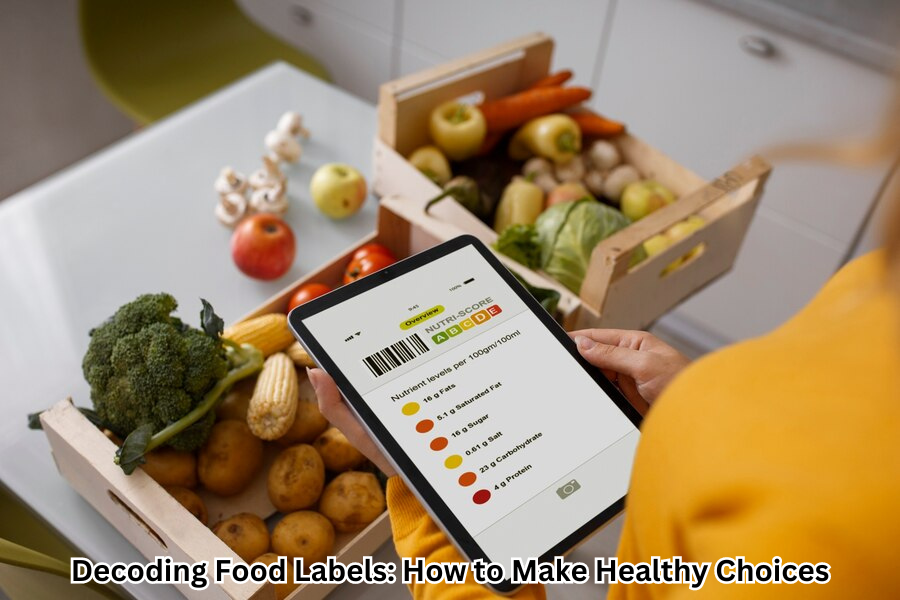It’s similar to traversing a maze of information to understand the nuances of food labels. Feeling overpowered by buzzwords like “organic,” “low-fat,” and “all-natural” is a common occurrence. Do not be alarmed! We will solve the puzzles around food labels in this in-depth guide, enabling you to make wise and healthful decisions. Together, we will unravel food labels and clarify the jargon around nutrition.

Comprehending Food Label Fundamentals
Start with the basics if you want to decipher food labels efficiently. From serving size to nutrient content, this section deconstructs the fundamental elements of a food label. Learn about the informational presentation techniques used by manufacturers and the importance of portion sizes in nutritional analysis.
Clarifying the Ingredients List: The Fine Print
Examine the ingredients list, which is the core of food labels. Learn how to spot preservatives, chemicals, and hidden sugars. Find the frequent names used to disguise sugar and other undesirable components under different labels.
Unlocking the Code of Nutrient Facts
Nutrient information is essential to evaluate the nutritional value of a product. Examine the interpretation of calorie, fat, carb, and protein information. Understand the distinction between saturated and total fats and how these nutrients affect your general health.
Managing Serving Sizes to Get the Right Amount
Serving sizes are sometimes misleading. This section explains the significance of comprehending serving size accuracy and how it affects the nutrients you consume daily. Learn useful advice on changing serving sizes to suit your dietary objectives.
Label Buzzwords: Organic, Non-GMO, and Other
“Organic” and “non-GMO” labels have come to represent healthful options. Find out what this jargon represents and how certifications affect the quality of the food you eat. Acquire the ability to distinguish between marketing speak and actual nutritional advantages.
Figuring Out Medical Claims: Real or Unreal?
On food packaging, phrases like “low-fat,” “sugar-free,” and “heart-healthy” are common. Analyze the veracity of these assertions by knowing the standards established by oversight organizations. Know when a label advocates for a healthier choice and when it’s just a sly marketing gimmick.
Interpreting Food Allergens and Dietary Limitations
Reading food labels is crucial for people who have dietary restrictions or allergies. Discover how to recognize common allergies, gluten-free choices, and other important details that guarantee a product’s safety and fit for your specific requirements.
Buying Wisely and Examining Labels
Equipped with this increased understanding, this section offers helpful pointers for quick and knowledgeable label reading while you shop for groceries. Learn time-saving techniques and how to spot warning signs so you can become an informed consumer who can quickly interpret labels to make better decisions.

Practical Examples: Utilizing Label Knowledge
We’ll examine actual food labels to make sure you understand. The practical method enables you to use the ideas you’ve learned throughout the handbook. Have faith in your abilities to navigate the aisles of your neighborhood grocery shop and make wise dietary choices.
The Path Ahead: Taking Charge of Your Dietary Decisions
Consider the process of decoding food labels as we get to the end of this tutorial. With this newfound knowledge, you can make better and more educated decisions. Recognize that reading labels is a skill that requires practice. Take charge of your nutrition journey by embracing the power of reading food labels.
In summary
Understanding food labels is a talent beyond nutrition; it is an effective way of assuming health responsibility. With the knowledge from this guide, make your way around the aisles of your grocery store, keeping in mind that each label reveals something about the product you will eat. Make decisions with your newly acquired knowledge to support a nourished and energetic you and to support your health objectives. Cheers to your successful decryption!
FAQs
Q1: Why should I bother decoding food labels and what is the relevance of doing so?
A: Consider food labels as a coded language that can help you decipher the nutritional secrets of your foods. Understanding them enables you to make decisions that align with your health objectives by ensuring that your food is healthy.
Q2: Do all these phrases like “organic” and “non-GMO” have any nutritional benefit, or are they merely marketing gimmicks?
A mixture, that’s what. Sure, some labels serve as marketing gimmicks, but labels like “organic” and “non-GMO” have requirements. Knowing these credentials might help you make healthier and more environmentally friendly decisions.
Q3: Is it possible to swiftly determine a product’s healthfulness from the food label alone?
A: Examine the ingredient list first. Shorter, more identifiable components are typically a sign of a healthier choice. Next, look up the balance of calories, fats, and sugars in the nutritional information. Quick scans give you a quick overview of a product’s nutritional profile.
Q4: Why do food labels provide serving sizes? Do they make sense?
A: Accurate serving sizes are important! They might not accurately represent how much people usually consume, but they are standardized for comparison. Pay attention to adjusting serving sizes depending on your intake to ensure accurate nutritional evaluations.
Q5: Do you have any advice on how to read food labels without wasting a lot of time in the grocery store?
A: Definitely! Pay attention to important details such as the nutritional data and ingredient list. Aim for warning signs such as high sugar content or unlisted ingredients. You’ll get an expert at identifying healthful selections throughout your supermarket run with practice.
Q6: My diet excludes gluten. How can I rapidly read food labels to determine which goods are gluten-free?
A: Start by looking for the “gluten-free” label, but don’t stop there. For any possible gluten sources, look through the ingredients. Recently, manufacturers have made it simpler for those with dietary requirements by making “gluten-free” obvious.
Q7: Should I be wary of any health claims made on food labels?
A: Unquestionably. While “sugar-free” or “low-fat” may seem healthful, they might be deceptive. To obtain the whole picture, always verify the components and nutritional statistics. Omissions might be just as important as inclusions in some situations.
Q8: How can I interpret food labels when it comes to hidden sugars?
A: Sugar goes by a lot of different names! Search for words that finish in “-ose,” such as sucrose or high fructose corn syrup. The likelihood of sugars being present in a product increases with their proximity to the top ingredient list.

